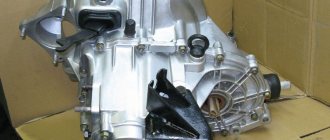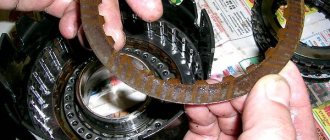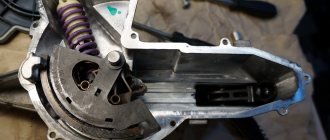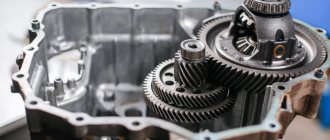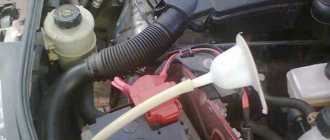The causes of noise in the gearbox depend on the type of transmission. So, in manual transmissions, a hum may appear, for example, due to wear of bearings, shaft gears, springs on the rocker, or differential. As for the automatic transmission, most often it hums due to low oil level, due to problems with the torque converter and the lever linkage.
To eliminate noise in the area of the box, it first makes sense to check the oil level in it. If it is not enough, then you need to top it up or replace it. As a temporary solution, an anti-noise additive is sometimes used in the box (it will not completely remove it, but at least reduce the operating noise). To effectively eliminate hum, the box should be dismantled, checked and fully repaired. Read about all the causes of noise in the gearbox in the article, and for brief information on why various types of noise appear in the gearbox, see the table.
| Conditions under which the gearbox makes noise | Possible causes of noise |
| Mechanical transmission | |
| Humming noise at speed (while driving) |
|
| At idle |
|
| When overclocking |
|
| When releasing the clutch |
|
| On a certain gear |
|
| In low gears (first, second) |
|
| In high gears (4 or 5) |
|
| In the cold |
|
| In neutral gear |
|
| Automatic transmission | |
| When driving at speed |
|
| In the cold |
|
| At idle |
|
| When overclocking |
|
| On a certain gear |
|
| At low speed (up to approximately 40...60 km/h) |
|
Manual transmissions are noisy for many reasons.
In mechanics, the reasons for the occurrence of hum in gearboxes are no less than in automatic transmissions. It must be remembered that the manual transmission is quite delicate, it likes moderate use and the absence of sudden movements. This even applies to sports gearboxes, which are most protected from damage during sports driving modes. However, such boxes are considered more reliable and durable than automatic types. This is a rather controversial truth, because there are different automatic transmissions and there are different manual transmissions. Many car enthusiasts prefer mechanics due to the fairly low cost of restoration. Although, it depends on what reason caused the hum in the manual transmission:
- wear or unequal replacement of elements of the main pair - the hum can continue for a long time without negative consequences, but, in the end, the box will fail;
- the drive bearings are worn out - they will hum for several weeks of active use and fall apart, causing not very pleasant consequences;
- gears of gears - if the hum is heard only in one gear, the culprit of such trouble is the gear of this particular gear;
- poor-quality assembly of the box is often the reason why a hum occurs due to a mismatch between the shaft and the gears;
- poor operation of the gear shift mechanism leads to inaccurate and uneven shifts;
- Individual and unexpected problems often arise in mechanical transmissions, which are diagnosed only after disassembly.
Such troubles are possible in every car. Of course, domestic cars are becoming more frequent visitors to professional service stations. But often expensive, technologically advanced foreign cars come to stations with questions about gearbox noise. It should be noted that in most cases, high-end cars do not present such problems. They are made of the highest quality and can last for many years without issue. But in some cases, it is not the engineer or assembler at the factory who is responsible for the box failure, but the driver himself.
Conclusion
As a result, I would like to emphasize the main thing: you should not neglect all kinds of signals that may come from the gearbox, in the form of howling, knocking or special markings on the “tidy”. In the end, repairs can be much more expensive.
In addition, trust the diagnostics, and therefore the disassembly of the box, only to certified or verified services, avoid the so-called “garage” repairmen, from whom you can only get a new “portion” of problems.
Let's sum it up
Many motorists are faced with such a problem as gearbox noise. It could be an automatic or manual transmission, any version of a modern robot or such a fashionable CVT. There are dozens of diseases of technical components and assemblies that can negatively affect this part of your car. Therefore, you should pay special attention to the features that the gearbox provides you during operation. If you simply miss the moment when bearings or other parts begin to hum, you may soon find yourself on the side of the road without the ability to move in your car.
There are many types of motorists. Some people want their vehicle to work perfectly, others are content with the fact that as long as the car is driving, there is no need to repair it. But most vehicle owners want the main components of the car to work well and efficiently. Therefore, do not neglect good diagnostics to find out which part of the box is causing the unpleasant hum. Most likely, after such diagnostics, you will want to restore the node. Has your car ever had problems with the gearbox that caused an unpleasant hum?
Why does the box howl and make noise?
The main source of noise of varying tones in the VAZ 2109 gearbox is worn out or unadjusted components. Typically, such malfunctions occur on cars with high mileage.
The main reasons why the gearbox on a VAZ 2109 rattles or makes noise are:
- Reduced lubrication level. If the amount of oil is insufficient or its condition is unsatisfactory, the gears and bearings begin to work without a lubricating film, which causes a high-frequency whine of the gearbox. A pair of gears and the fifth gear shaft, located at the maximum height from the lubricant level in the manual transmission housing, are especially susceptible to this phenomenon. When the amount of oil drops significantly, all speeds begin to howl. Sometimes the sound is present only when the box is cold and disappears as it warms up. This is a sign that the liquid is too thick and hardens at low temperatures. Very thin oil, on the other hand, will cause a loud whine as it warms up.
- Worn drive shaft bearings. This is one of the most common causes of rustling noise when the gearbox is operating. The gearbox makes noise when coasting or when the car is stationary and idling.
- Wear of gears in the box. If the gearbox hums in certain gears, then the cause should be sought in wear or chipping of the gear teeth.
- Faulty locking rings. These parts are installed on the lateral conical surfaces of the secondary shaft gears of the box. They have gaps and can rotate freely along with the breadcrumbs. When the ring wears out, cracks and deformations may appear on it, which is why gears begin to shift with a bang.
- Worn synchronizer clutch. If the synchronizer itself fails, a cracking sound appears when gears are engaged and spontaneous speed loss occurs. To eliminate this defect, it is necessary to replace parts.
- Incorrect clutch adjustment. If the setting of the mechanism does not correspond to the norm, then the disks do not turn off completely when the pedal is pressed to the bottom position. In this case, a crunching sound is observed during switching and a characteristic foreign smell is felt due to the burning of the disks.
- Worn release bearing. There is a rustling noise or rumble, but it disappears when the driver depresses the clutch pedal.
Conclusion
As a result, I would like to emphasize the main thing: you should not neglect all kinds of signals that may come from the gearbox, in the form of howling, knocking or special markings on the “tidy”. In the end, repairs can be much more expensive.
In addition, trust the diagnostics, and therefore the disassembly of the box, only to certified or verified services, avoid the so-called “garage” repairmen, from whom you can only get a new “portion” of problems.
For those with automatic
If your car has an automatic transmission. It will not hurt you to know the modes in which your machine can operate:
- P – For parking and starting the engine. Switching to this mode is possible only after the machine has completely stopped.
- R – To move backwards. Switching to this mode is also possible only after stopping the car and with the brake pedal pressed.
- N – Neutral. When the engine is completely disconnected from the gearbox.
- D – Moving forward without restrictions on gear shifting (the most commonly used operating mode of the automatic transmission).
- D3(S) – Low gears for climbing and braking engines on descents.
- D2 – Mode for difficult conditions (slippery or mountainous roads). Gears above second are not shifted, that is, only first and second gears are engaged.
- D1(L) - Movement occurs only in 1st gear, used off-road on mud, snow or ice, where you need to drive without changing the throttle, and also to overcome steep climbs.
The automatic transmission also has a button on the mode shift lever with the inscription O/D OFF. When it is turned on, the inclusion is prohibited, increasing the gears of the analogue of the 5th gear of the manual transmission. That is, if your automatic machine has 4 gears for moving forward, then for more dynamic acceleration it will use only three lower gears.
About a faulty automatic transmission, an automatic transmission is much more complex than those encountered with a manual transmission, and the chances of repairing it in your garage are slim. But despite this, you still need to know something about it, if only in order not to harm it through improper use.
What to do if the box howls
The first thing a car owner should think about when a howling noise appears in the transmission is a transmission fluid leak. Inspect the car's riser for oil stains, assess the oil level in the box using the dipstick, which most car models have. If the transmission fluid level is below the minimum mark, it must be topped up immediately. Use only the brand of oil that comes in the box. You cannot mix liquids from different manufacturers. You should know that automatic transmissions are very sensitive to the level of lubrication, so an overflow of transmission fluid is as unacceptable as a lack of it. If the oil has not been changed for a long time, it should be done. Automatic transmissions are especially sensitive to the quality of transmission fluid.
If it was not possible to eliminate the howling of the box by replacing or adding oil, you need to go to a service station for diagnostics. Specialists will assess the condition of the transmission and tell you how much repair is needed.
If you decide to sort through the box, you should take into account that the cost of such work is quite high. That is why it is advisable to purchase new original spare parts. Only in this case can you count on a long service life of the transmission after repair. Buying used spare parts or cheap parts from a dubious manufacturer is an imaginary savings. There is a high probability that soon after such repairs the gearbox will have to be disassembled again.
If the main pair is damaged, it is rarely possible to get by only by replacing it. Usually in such a situation other parts also suffer, so you need to evaluate their condition and, if necessary, also replace them.
Sometimes repairing a box turns out to be very difficult and expensive. In this case, it is advisable to replace the entire transmission. You can buy a new unit or find a used box in working condition.
Low transmission oil level
Oil leaks from the gearbox are a very common occurrence. If the problem is ignored, its level will eventually drop to a critical level. This will cause a drop in pressure in the gearbox housing and an acute shortage of lubricant necessary for its correct operation.
The first sign of a lack of oil in the transmission is increased noise during operation. In this case, shifting gears is also significantly difficult: the lever is difficult to move through the gear positions, and sometimes you can hear the crunching of gears; gears can “knock out”.
To prevent this, you should constantly monitor the oil level and, if necessary, add it.
It is equally important to observe the frequency of replacement, select the right brand and take into account the seasonality factor when choosing a new one. This means that the summer type of oil should be thicker and more viscous in composition, and the winter type - vice versa
Noise additive in gearbox
As you can see, you can give an affirmative answer to the question whether the automatic transmission can hum. At the same time, as in any other unit, noise in an automatic transmission can appear for various reasons (wear, malfunctions, loss of properties of ATF transmission oil, etc.). It is also a common situation when noise appears in the automatic transmission after changing the oil. This is often due to the fact that unsuitable oils are used, errors were made during replacement, etc.
Owners often note that noise in the automatic transmission occurs in neutral and in parking; in some cases, noise in the automatic transmission appears when the car is stationary or in motion when the gear is engaged. It also happens that the problem manifests itself only under certain conditions and modes (for example, noise in the automatic transmission when engaging reverse gear or howling of the automatic transmission during acceleration).
In any case, the problem needs to be solved. Moreover, in the case of a manual transmission, unlike an automatic transmission, it is easier to determine the cause of the malfunction and also to eliminate the defect. If the release bearing of a VAZ 2114 is humming, the noise in the gearbox disappears when the clutch is pressed, the howling of the Lada Granta gearbox is noticed, specialists from any car service center know how to fix the problem and get rid of the noise and howling.
Moreover, the list of “childhood” diseases allows you to quickly find out why the gearbox on a Lada Granta or other car with a manual transmission is humming. At the same time, diagnosing a manual transmission actually does not take much time. The repair itself is also often limited to changing the oil and replacing the manual transmission clutch or, in the worst case, rebuilding the transmission and replacing worn parts.
When it comes to automatic transmissions, both on domestic and foreign cars, everything is much more complicated. Owners often ask why the gearbox hums on a Lada Granta automatic transmission, or the automatic transmission howls on a Nissan, Lexus, Audi or BMW. So, in this case, diagnosing the cause is difficult and expensive. It is for this reason that quite often owners of cars with automatic or manual transmission begin to look towards additives.
As is known, an additive in a manual transmission to reduce noise or an additive in the transmission oil of an automatic transmission in some cases can reduce or completely eliminate the appearance of extraneous sounds. In practice, manufacturers of such compounds promise normalization of unit operation, increased service life, softer and smoother operation of the automatic transmission, etc.
There are a large number of products from different manufacturers on the market, and among additives for automatic transmissions we can single out Liqui Moly and Xado. In the first case, the Liqui Moly ATF Additive is quite popular.
This additive in automatic transmissions has a positive effect on the oil, slows down its aging and oxidation, and also helps restore the elasticity of rubber and plastic seals. This property makes it possible to stop oil leaks through oil seals, gaskets and seals.
At the same time, intensive cleaning of the hydraulic unit channels occurs, a protective film is formed on the parts, which improves the operation of the box, reduces noise and eliminates extraneous sounds. According to the manufacturer, ATF Additive increases the service life of the automatic transmission.
This additive can be mixed with any ATF fluids, since the composition does not contain additives that can lead to the loss of properties of the base oil or lead to swelling of the rubber. In fact, the additive has the same components as oil, only in high concentration. The composition does not affect the coefficient of friction, that is, there is no risk of friction clutches slipping, etc.
You can also select XADO revitalizant (gel-revitalizant EX120) for automatic transmissions. This solution protects the box from wear and tear and is also a means of partial (restorative) repair. According to the manufacturer, the Hado automatic transmission additive protects surfaces and restores rubbing parts, which allows you to get rid of noise.
A special metal-ceramic coating is formed on the surfaces, and the geometry of the parts is restored. Revitalizant itself can be used in all types of automatic transmissions, added to any oil, since the additive does not enter into chemical reactions and does not cause changes in viscosity, friction, or other physical and chemical properties of ATF.
Howling or humming in the gearbox: causes of malfunctions, diagnosis and elimination
So, before diagnosing a gearbox, it is necessary to consider the main causes of hum and howling in manual and automatic transmissions, common faults and methods for eliminating them. Often, owners of cars with a manual or automatic transmission during operation are faced with such a sign of problems or malfunctions, which are accompanied by a hum or howling in the box.
In this case, an extraneous sound can occur when switching one or several gears, while driving in different or all gears, etc. The intensity of the sound can also be different.
Let's start with the mechanics. First of all, taking into account the design features of specific mechanisms in manual transmissions, noise may be normal. To a greater extent, this applies to budget cars. However, if the noise in the box is strong and drowns out the operation of the internal combustion engine, this indicates that you need to look for the problem in the box itself.
Article on the topic: Gas-powered diesel engine: operating features, advantages and disadvantages of gas-diesel
Another cause of noise may be not the gearbox, but other components and elements associated with it (clutch, wear of the release bearing, wear of transmission elements, etc.). In any case, it is necessary to identify the problem through diagnosis and fix it as soon as possible.
To understand why the manual transmission howls, you need to pay attention to the following points. Although a manual transmission is simpler than an automatic transmission, this unit is still structurally complex
This means that extraneous sound (howling or hum) in the box can appear for various reasons.
The main causes of noise in manual transmissions:
- insufficient amount of lubricating fluid (a hum or howl is heard in high gears and absent in low gears);
- wear of the input shaft bearing or drive gear bearing (changing noise in the box in neutral mode when the clutch is depressed);
- failure of synchronizers and gears (the appearance of an extraneous sound with a grinding sound when one or more gears are engaged, gear shifting is difficult);
- wear or poor-quality replacement of parts of the main pair (the occurrence of a prolonged hum can lead to failure of the manual transmission);
- poor-quality assembly after a major overhaul of the gearbox (the appearance of a hum due to an improper fit of the shaft/gear pair), etc.
Now let's look at why an automatic transmission howls. Considering that an automatic transmission is a complex and high-tech unit, normally such a gearbox operates somewhat quieter than a manual transmission.
A serviceable automatic transmission makes virtually no extraneous noise, vibrations, squeaks or other sounds. For this reason, if any noise occurs, immediately stop using the vehicle and carry out diagnostics to avoid possible damage to expensive components and elements of the box.
After diagnostics, it is often necessary to dismantle the box for subsequent disassembly and troubleshooting. Only after this can we talk about an integrated approach to high-quality troubleshooting.
The main causes of noise in automatic transmissions:
- insufficient level of transmission fluid (the operation of the gearbox is accompanied by jerks during shifts and a prolonged howl with a changing tone);
- clogged automatic transmission filter (filter replacement with complete ATF replacement);
- failure of gear engagement in the pump (increasing noise with the appearance of a hum);
- abrasion or damage to the teeth on the drive gear or shaft (noise or hum of bearings)
- wear of parts of the main pair (the appearance of backlashes, as a result, the occurrence of extraneous noise);
- displacement during installation or after repair of gears, resulting in the appearance of excessive friction of parts (increasing hum when one of the gears is engaged);
- poor fastening of the axle shafts (the appearance of a hum or howling when the speed limit increases or decreases), etc.
Article on the topic: All-wheel drive transmission: how the all-wheel drive circuit is designed and works
How to identify automatic transmission faults by sound
The ability to diagnose a unit by sounds applies not only to the engine, but also to the gearbox, as well as other components of the vehicle. The automatic machine is also no exception. This approach allows you to quickly identify suspicious automatic transmission noises in the event of malfunctions and, in some cases, localize the breakdown.
At the initial stage, you need to make sure that it is the automatic transmission that is humming. To do this, you should check the pump, the quality of the engine cooling system, evaluate the operation of the engine, generator, check the timing belts or chain, power steering, steering elements, bearings, etc.
If the noise definitely comes from the automatic transmission, you need to pay attention to its frequency, tone and volume. You should evaluate the operation of the transmission in motion under load in different modes, also turn it on and drive in reverse gear, listen to how the automatic transmission works at idle.
During operation of the automatic transmission, a howling, buzzing, crackling, grinding, hum, etc. may be heard. Metallic impacts of greater or lesser intensity and sounds of surface friction may also be heard. Based on the nature and characteristics of automatic transmission noise, you can determine the nature of the malfunction.
For example, when braking, you can hear a loud sound similar to a howl. This noise is associated with the torque converter and is often not a serious problem if it occurs only briefly. If the automatic transmission howls constantly, and the tone changes depending on the engine speed, then this may indicate the following automatic transmission problems:
- wear of the automatic transmission oil pump gears is possible;
- insufficient automatic transmission oil level;
- transmission oil has become unusable;
- seal failure, air enters the oil pump;
- the engagement of the oil pump gears is broken;
Also, in some cases, the automatic transmission buzzes. Moreover, the intensity of such sound directly depends on the speed of rotation of the output shaft. Such noises arise as a result of increased vibration, as well as oscillations of the line pressure valve (regulator valve). To get rid of the problem, it is often enough to replace the seals, cuffs and other sealing elements.
We also recommend reading the article about why the automatic transmission kicks and pushes. From this article you will learn about the main reasons why kicks and jolts of an automatic transmission occur; an automatic transmission jerks on the move, when switching speeds, modes, etc.
Often rattling can be heard in the automatic transmission, especially when the engine is running at low speeds. In this case, diagnostics of the gas turbine engine is needed to determine its performance. Possible problems include damage to the hydraulic pump blades, problems with the turbine wheel, and malfunctions of the damper springs.
Frequent vibrations and rattling while driving appear as a result of damage to the engine flywheel, to which the torque converter is attached. In this case, a characteristic feature is that the vibrations disappear for a short time if the selector is switched from mode “D” to “P” or “N”.
Even when idling, you can hear the clanging of metal in the automatic transmission area. Often the cause is clutch gaskets (friction discs) that are sufficiently worn out. To eliminate such automatic transmission clanging, you need to change the clutches in batches. This operation involves removing the automatic transmission.
You can also often hear a hum and grinding noise in the differential area. This noise is often mistaken for wheel bearing noise. If the automatic transmission differential hums, this may indicate that the gear teeth, bearings and other elements of the mechanism are worn out.
In this case, the problem must be solved immediately, since the differential elements are likely to jam, play in the satellite occurs, wear increases, etc. At the same time, noise may occur in the automatic transmission when the gear is engaged, when the driver switches from one operating mode of the automatic transmission to another. Most often, the cause is wear or breakdown of the elements of the gears involved in the ranks of the planetary mechanism.
If the noise changes (becomes louder, the pitch changes) when the automatic transmission selector is switched to R (reverse) mode, this often indicates that there are problems with the thrust bearings (liners).
The first gear is buzzing - causes, consequences
The gearbox is humming, first gear - congratulations, your case is 80% of manual transmission breakdowns. The first is the most working gear. We start from here; here is the maximum load, since it is necessary to move a car from the zero mark, which when loaded can weigh more than one and a half tons. The load on gears and teeth is enormous. In addition, the winter factor is added, because central Russia means almost five months of negative temperatures, when transmission oil thickens significantly. The transmission hums for two main reasons:
- Insufficient oil level in the gearbox. Accordingly, semi-dry or dry friction;
- The first gear bearing begins to deteriorate.
It is worth noting that in 5% of cases this may be due to a design feature, mainly on Russian cars. The transmission may hum when leaving the conveyor. Moreover, after a run of 15–25,000 km, the bearing will look and feel almost the same as new. But at the same time, the gearbox hums boringly at first speed.
Price issue
The cost of repairing each box is determined by the number of worn parts.
When performing work in the service, the average cost will be:
- gearbox overhaul - from 2500 rubles;
- removal and installation of the unit - about 4,000 rubles;
- changing the oil in the box - up to 1000 rubles;
- installation of new bearings on the input shaft - approximately 5,000 rubles.
Service costs are approximate and may differ depending on the city, workshop location and general condition of the box. In most cases, it is more profitable to purchase and install a less worn unit than to rebuild an old one.
Diagnostics and repair
As for transmission repair, it is very important to first carry out a correct diagnosis of a possible malfunction of the unit, try to determine why the gearbox makes a howling noise without removing the unit. Usually the box does not howl in all modes, but at some speeds
If a howl accompanies movement in 1st, 2nd, 3rd gears, then this usually indicates problems with the bearing connecting the primary and secondary shafts, or more precisely, its wear. The only solution is to replace it. But there is a small nuance - if the bearing is a needle bearing without a cage, then simply replacing the needles may not help. This will require replacement of the shafts. And this is already a serious repair.
It is also possible that there may be a howling noise when the working pair of gears located on the primary and secondary shafts of these gears wear out. Or due to poor quality factory processing and installation after repair. One of the characteristic features of gear wear is howling under load and its reduction in the absence of traction. A worn bearing will make noise regardless of whether there is a load or not. But you can determine the exact reasons only by disassembling the gearbox and showing it to a specialist if the repair is done by yourself.
If there is a whine in 5th gear, the first thing that needs to be done is to check and add oil to the unit if necessary, as discussed earlier. But if this does not help, then most likely the fifth gear gear needs to be replaced. This is determined by opening the box. Preliminarily, by the sound at high speed, you can determine the cause - if there is an outright whine, the gear is worn out; if there is a squeaking sound over 100 km/h, it is most likely the bearing.
If the gearbox of front-wheel drive cars howls in all gears, then there is a high probability of wear on the input shaft bearing. But replacing it often does not lead to a positive result, so changing it in the presence of minor howling is not recommended.
Or maybe it's not a box at all?
When diagnosing a gearbox, be sure to carefully consider the fact that if there is a constantly increasing howl in all gears, it may not be only the gearbox that is to blame for the origin of the sounds. On models with a classic drive, the source of the howl may be the rear axle gearbox, which has a bevel hypoid gear. If the gear teeth are worn out or there is significant play in the bearings, a howl will accompany all driving modes. Similar symptoms also accompany an all-wheel drive vehicle when the front axle malfunctions. The sound will come from the center of the cabin and be observed under load.
Tribotechnical composition of the manual transmission - additional protection with every shift
In addition to high-quality gear oil, problems with manual transmissions can be avoided by using tribological compounds. At their core, they can be classified as additives, but with one very significant amendment. They do not change the physical and chemical properties of the oil, but only complement it. The first thing the tribological compound does is restore the geometry of the gear teeth. A larger amount of oil is retained on the surface of rubbing parts, and clearances are optimized.
avtoexperts.ru
I think no one will argue that any gearbox is one of the most key parts in a car. Therefore, all problems that sooner or later arise with the checkpoint must be eliminated in a timely manner. After all, this is a rather serious mechanism, the repair of which in certain situations can be very expensive and comparable even to engine repair.
During operation, the box may exhibit various troubles that stand out not only due to the characteristic sound. But, using today’s example, let’s take the hum as a basis, what problems can it indicate and what consequences can the car owner expect?
What’s interesting is that howling can be completely different, depending on the intensity of traffic, speed, gear engaged, and the like, but its symptoms usually boil down to one list of problems.
By the way, it may not always indicate that problems have arisen with the checkpoint. It is quite possible that this is a design feature of a particular mechanism or the device has just been repaired, that is, the parts have not yet gotten used to it. In addition, the cause of noise can be not only the gearbox itself, but also the units associated with it, for example, the clutch, if we are talking about “mechanics”. The spring has become loose, the release bearing has worn out, etc.
Operating principle
The purpose of the device is to ensure uninterrupted connection and disconnection of the clutch discs when the driver presses the pedal.
The operating principle is as follows:
- Through the action of the pressure plate, the driven shaft is pressed against the clutch flywheel.
- The system generates pressure, which is applied to the pressure shaft; this is ensured through the use of a diaphragm spring. Its inner petals are affected by a bearing device.
- The part moves, resulting in separation of the shafts through the action of the fork.
User Alexey Romanov published a video that will help you understand the principle of operation of the clutch system and release bearing.
How to eliminate noise and hum in a gearbox: an alternative to transmission additives
January 25th, 2015 Victor
The “howl” of the gearbox bothers car owners just like any other extraneous sound in the car. The functioning of a serviceable gearbox - mixing of oil, engagement of teeth, operation of bearings - should not be heard while driving. Therefore, the “singing” of the transmission is one of the first reasons to visit the diagnostics.
As a rule, this very “singing” is caused by banal reasons:
- Increasing gaps between individual parts.
- Teeth wear.
- Incorrect oil viscosity.
gearbox additives without any hesitation.
. They pour it in... And they wait for a miracle effect, which you won’t find during the day, even if you look very hard.
The problem is that such drugs are poorly studied. Many of them form a protective film for a limited period of action, so it is not possible to evaluate any long-term positive effect.
The main danger posed by transmission additives
, – corrosive and abrasive wear. This primarily concerns layered, metal-clad additives, and metal conditioners. This feature negates all the advantages of the above-mentioned drugs. Therefore, car owners are looking for a worthy alternative, which is friction geomodifiers. Their main advantages:
1) Possibility of in-place repairs.
2) Formation of a protective layer on the surfaces of mechanisms that is absolutely safe for transmission.
3) Reduced wear rate.
4) Improvement of friction indicators.
The disadvantages of friction geomodifiers include the need to strictly follow the instructions, which is somewhat higher than the cost in the case of additives. Sellers of such products claim 100% effectiveness of the compositions, although they honestly admit: if the wear is more than 60–70%, nothing will help except a complete overhaul with disassembly.
Let's look at what friction geomodifiers are using the example of RVS-Master Tr3, Tr5. Let's figure out why anti-drone additives in gearboxes are significantly inferior to these compounds.
The Finnish-made product received a certificate of compliance with Russian state standards
. The composition is based on magnesium silicates. RBC particles do not change the chemical composition of the oil.
Under the influence of temperature, a new crystal lattice is built on the friction surface: an exchange of Mg and Fe atoms occurs, and a protective metal-ceramic coating is formed. This way the nominal dimensions of the parts are restored. The standard friction system creates an optimal secondary structure that is ideal for the given operating conditions.
